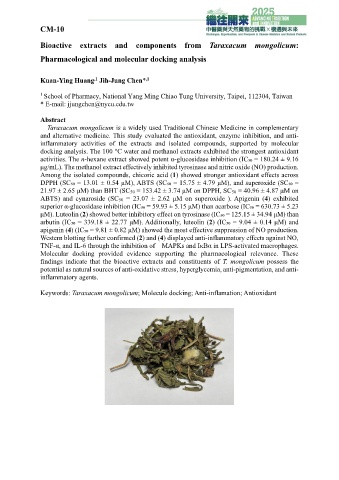Page 277 - 2025中醫藥與天然藥物聯合學術研討會-中醫藥與天然藥物的挑戰X機遇與未來大會手冊
P. 277
CM-10
Bioactive extracts and components from Taraxacum mongolicum:
Pharmacological and molecular docking analysis
,1
Kuan-Ying Huang Jih-Jung Chen* ,1
1 School of Pharmacy, National Yang Ming Chiao Tung University, Taipei, 112304, Taiwan
* E-mail: jjungchen@nycu.edu.tw
Abstract
Taraxacum mongolicum is a widely used Traditional Chinese Medicine in complementary
and alternative medicine. This study evaluated the antioxidant, enzyme inhibition, and anti-
inflammatory activities of the extracts and isolated compounds, supported by molecular
docking analysis. The 100 °C water and methanol extracts exhibited the strongest antioxidant
activities. The n-hexane extract showed potent α-glucosidase inhibition (IC₅₀ = 180.24 ± 9.16
μg/mL). The methanol extract effectively inhibited tyrosinase and nitric oxide (NO) production.
Among the isolated compounds, chicoric acid (1) showed stronger antioxidant effects across
DPPH (SC₅₀ = 13.01 ± 0.54 μM), ABTS (SC₅₀ = 15.75 ± 4.79 μM), and superoxide (SC₅₀ =
21.97 ± 2.65 μM) than BHT (SC50 = 153.42 ± 3.74 μM on DPPH, SC50 = 40.96 ± 4.87 μM on
ABTS) and cynaroside (SC50 = 23.07 ± 2.62 μM on superoxide ). Apigenin (4) exhibited
superior α-glucosidase inhibition (IC₅₀ = 59.93 ± 5.15 μM) than acarbose (IC₅₀ = 630.73 ± 5.23
μM). Luteolin (2) showed better inhibitory effect on tyrosinase (IC₅₀ = 125.15 ± 34.94 μM) than
arbutin (IC₅₀ = 339.18 ± 22.77 μM). Additionally, luteolin (2) (IC₅₀ = 9.04 ± 0.14 μM) and
apigenin (4) (IC₅₀ = 9.81 ± 0.82 μM) showed the most effective suppression of NO production.
Western blotting further confirmed (2) and (4) displayed anti-inflammatory effects against NO,
TNF-α, and IL-6 through the inhibition of MAPKs and IκBα in LPS-activated macrophages.
Molecular docking provided evidence supporting the pharmacological relevance. These
findings indicate that the bioactive extracts and constituents of T. mongolicum possess the
potential as natural sources of anti-oxidative stress, hyperglycemia, anti-pigmentation, and anti-
inflammatory agents.
Keywords: Taraxacum mongolicum; Molecule docking; Anti-inflamation; Antioxidant

